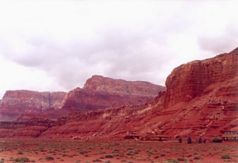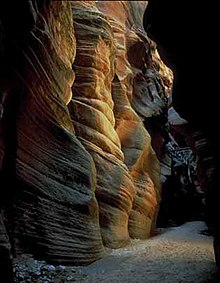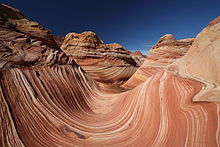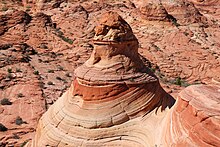Vermilion Cliffs National Monument
| Vermilion Cliffs National Monument | ||
|---|---|---|
| The eponymous cliff over the Colorado River | ||
|
|
||
| Location: | Arizona , United States | |
| Specialty: | Sandstone formations, canyons and cliffs | |
| Next city: | page | |
| Surface: | 1,189.8 km² | |
| Founding: | November 9, 2000 | |
Vermilion Cliffs National Monument is a protected area by the type of National Monuments in Coconino County of the US -Bundesstaats Arizona . It includes a high plateau with a desert climate that slopes down to the Colorado River at the cliffs that give it its name , several canyons and other rock formations.
The over 1000 km² large reserve was established by President Bill Clinton in 2000 and is under the administration of the Bureau of Land Management , an authority under the umbrella of the US Department of the Interior . The name vermilion comes from the English name of a mineral that is referred to in German as cinnabarite or cinnabar. It is used as a red pigment .
description
Vermilion Cliffs National Monument is located in the north of the state on the state border with Utah , which forms its northern border. In the northeast lies the Glen Canyon National Recreation Area , the eastern and southern borders are formed by US Highway 89A below the eponymous cliffs of the Colorado River . In the southwest the area borders on the Kaibab National Forest , a national forest . The reserve forms the easternmost part of the so-called Arizona Strip , the almost unpopulated and inaccessible northwestern part of Arizona, which is separated from the rest of the state by the Colorado River.
history
Despite the rugged terrain and the dryness of the area, it was settled around 12,000 years ago. Several hundred settlements, mainly pueblos , of the Anasazi Indians have been found so far. In addition, the rock faces are rich in petroglyphs . With the expedition of two Spanish Franciscan Padres, Francisco Antanasio Domínguez and Silvestre Vélez de Escalante , the first whites came through today's protected area in 1776, and from 1860 followers of the Church of Jesus Christ of Latter-day Saints ("Mormons") settled in the Region as settlers. In 1869 John Wesley Powell's expedition came along the Colorado River through the area and in 1871 John D. Lee built a ferry across the Colorado below the cliffs with the support of the Mormon Church. Lee's Ferry was replaced by the Navajo Bridge in 1928 and now forms the border between Grand Canyon National Park and the upstream Glen Canyon National Recreation Area. This is where the multi-day rafting tours through the Grand Canyon begin .
Today's National Monument is almost inaccessible and barren, making it uninteresting for economic use. Only after the expulsion of the most distinctive geological formations as a wilderness area in 1984 under the name of Paria Canyon-Vermilion Cliffs Wilderness of sporadic tourism was regulated, the end of 2000 presented President Clinton the wilderness area and surrounded by it on three sides plateau under the protection the federal government .
Geological formations
Paria Plateau: Geologically, the cap rocks of the Paria Plateau are sedimentary rocks of the Paleozoic Era . The plateau slopes from north-west to south-east, and run-off precipitation has carved canyons into the rock that exposed older layers of the Precambrian . The National Monument only includes the uppermost of these geological formations, the Colorado River, into which the canyons flow, belongs to the Grand Canyon National Park , the easternmost branch of which almost borders the National Monument.
Vermilion Cliffs: The eponymous cliffs are made of reddish Navajo sandstone , which towers around 1000 m over the Colorado River. Below them are formations made of softer siltstone and slate , which is eroded by weathering .
Paria Canyon and Buckskin Gulch: Paria Canyon in the northeast of the reserve is the valley of the lower reaches of the Paria River , which drains the high plateau. Buckskin Gulch is a slot canyon that flows into Paria Canyon. Both are enclosed by vertical walls that can be several hundred meters high. At the narrowest points, Buckskin Gulch is only less than a meter wide, in the lower half of Paria Canyon the walls are about 100 m apart. The full length can be hiked in three to five days.
Coyote Buttes with The Wave : A bizarre formation of petrified sand dunes in the northwest of the monument is one of the most spectacular photo opportunities for nature photographers.
Ecosystem
The protected area is in the area of the arid climate and is defined as a desert . The plain on the high plateau is hardly overgrown, at the foot of the cliffs there are some grass communities. On the Paria River in the lower half of the canyon of the same name there is a softwood floodplain . The very rare and endangered Asclepias welshii , which is only known from a few locations in Arizona and neighboring Utah , also grows here .
Twenty species of birds of prey , including the peregrine falcon and the California condor , which has died out in the wild and reintroduced into the wild, live in the area. Also bighorn sheep , pronghorns , coyotes and pumas .
tourism
The concept of the protected area is based on the experience of solitude in great nature. Therefore, only day visitors are allowed to freely enter Paria Canyon with Buckskin Gulch. A maximum of 20 people per day are permitted for multi-day tours such as crossing the canyon system. There is no free access to the other core area of Coyote Buttes North ( The Wave ) and South, only 20 people are allowed a day. Half of the permits can be applied for months in advance via the administration's website, the rest of the places are allocated early in the morning in a raffle. The Paria Plateau and the cliffs are freely accessible.
Protected areas in the area
- Grand Canyon National Park
- Grand Staircase-Escalante National Monument
- Grand Canyon-Parashant National Monument
- Pipe Spring National Monument
Not a formal sanctuary, but another geological attraction is Antelope Canyon southeast of Page on the other bank of the Colorado River.
Web links
- Bureau of Land Management: Vermilion Cliffs National Monument (official site )
- Wilderness.net: Paria Canyon-Vermilion Cliffs Wilderness - about the Wilderness Area with the most prominent points of the protected area (English)
- travel-offthemaps.com: Access information to "The Wave" (German)






